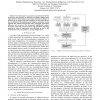ASPDAC
2005
ACM
14 years 5 months ago
2005
ACM
— At system level, intensively analyzing the system application will produce a variety of useful characteristics and provide designers valuable exploration indications. In this p...
ISCAS
2005
IEEE
14 years 5 months ago
2005
IEEE
— In this paper, we propose an interconnect-driven framework that performs an efficient and effective design space exploration for deep submicron processor architecture design. ...
IPPS
2006
IEEE
14 years 5 months ago
2006
IEEE
Design space exploration of multiprocessors on chip requires both automatic performance analysis techniques and efficient multiprocessors configuration performance evaluation. Pr...
CODES
2006
IEEE
14 years 5 months ago
2006
IEEE
Transaction-level modeling has been touted to improve simulation performance and modeling efficiency for early design space exploration. But no tools are available to generate suc...
CODES
2006
IEEE
14 years 5 months ago
2006
IEEE
Embedded system optimization typically considers objectives such as cost, timing, buffer sizes and power consumption. Robustness criteria, i.e. sensitivity of the system to variat...
SIES
2007
IEEE
14 years 6 months ago
2007
IEEE
— High level synthesis is one of the next major steps to improve the hw/sw co-design process. The advantages of high nthesis are two-fold. At first the level of abstraction is r...
MICRO
2007
IEEE
14 years 6 months ago
2007
IEEE
A significant part of future microprocessor real estate will be dedicated to L2 or L3 caches. These on-chip caches will heavily impact processor performance, power dissipation, a...
DSD
2007
IEEE
14 years 6 months ago
2007
IEEE
Design space exploration is used to shorten the design time of System-on-Chips (SoCs). The models used in the exploration need to be both accurate and fast to simulate. This paper...
CODES
2007
IEEE
14 years 6 months ago
2007
IEEE
In this paper, we present the Daedalus framework, which allows for traversing the path from sequential application specification to a working MP-SoC prototype in FPGA technology ...
ISVLSI
2008
IEEE
14 years 6 months ago
2008
IEEE
Future embedded systems will integrate hundreds of processors. Current design space exploration methods cannot cope with such a complexity. It is mandatory to extend these methods...


